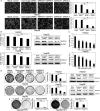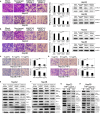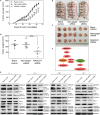MARCH1 encourages tumour progression of hepatocellular carcinoma via regulation of PI3K-AKT-β-catenin pathways
- PMID: 30793486
- PMCID: PMC6484336
- DOI: 10.1111/jcmm.14235
MARCH1 encourages tumour progression of hepatocellular carcinoma via regulation of PI3K-AKT-β-catenin pathways
Abstract
Membrane-associated RING-CH-1 (MARCH1) is a membrane-anchored E3 ubiquitin ligase that is involved in a variety of cellular processes. MARCH1 was aberrantly expressed as a tumour promoter in ovarian cancer, but the signalling about the molecular mechanism has not yet been fully illuminated. Here, we first determined that MARCH1 was obviously highly expressed in human hepatocellular carcinoma samples and cells. In addition, our findings demonstrated that the proliferation, migration and invasion of hepatocellular carcinoma were suppressed, but the apoptosis was increased, as a result of MARCH1 knockdown by either siRNA targeting MARCH1 or pirarubicin treatment. Conversely, the proliferation, migration and invasion of hepatocellular carcinoma were obviously accelerated, and the apoptosis was decreased, by transfecting the MARCH1 plasmid to make MARCH1 overexpressed. Moreover, in vivo, the results exhibited a significant inhibition of the growth of hepatocellular carcinoma in nude mice, which were given an intra-tumour injection of siRNA targeting MARCH1. Furthermore, our study concluded that MARCH1 functions as a tumour promoter, and its role was up-regulated the PI3K-AKT-β-catenin pathways both in vitro and in vivo. In summary, our work determined that MARCH1 has an important role in the development and progression of hepatocellular carcinoma and may be used as a novel potential molecular therapeutic target in the future treatment of hepatocellular carcinoma.
Keywords: Invasion; MARCH1; apoptosis; hepatocellular carcinoma; migration; nude mouse model; pathways; pirarubicin; proliferation.
© 2019 The Authors. Journal of Cellular and Molecular Medicine published by John Wiley & Sons Ltd and Foundation for Cellular and Molecular Medicine.
Conflict of interest statement
The authors declare that they have no competing financial interests.
Figures







Similar articles
-
Secalonic Acid-F, a Novel Mycotoxin, Represses the Progression of Hepatocellular Carcinoma via MARCH1 Regulation of the PI3K/AKT/β-catenin Signaling Pathway.Molecules. 2019 Jan 22;24(3):393. doi: 10.3390/molecules24030393. Molecules. 2019. PMID: 30678274 Free PMC article.
-
Resveratrol inhibits the malignant progression of hepatocellular carcinoma via MARCH1-induced regulation of PTEN/AKT signaling.Aging (Albany NY). 2020 Jun 12;12(12):11717-11731. doi: 10.18632/aging.103338. Epub 2020 Jun 12. Aging (Albany NY). 2020. PMID: 32530437 Free PMC article.
-
Upregulation of lncRNA FER1L4 suppresses the proliferation and migration of the hepatocellular carcinoma via regulating PI3K/AKT signal pathway.J Cell Biochem. 2019 Apr;120(4):6781-6788. doi: 10.1002/jcb.27980. Epub 2018 Nov 1. J Cell Biochem. 2019. PMID: 30382631
-
Strategic advancement of E3 ubiquitin ligase in the management of hepatocellular carcinoma.Med Oncol. 2024 Jun 18;41(7):178. doi: 10.1007/s12032-024-02411-8. Med Oncol. 2024. PMID: 38888684 Review.
-
Molecular and functional genetics of hepatocellular carcinoma.Front Biosci (Schol Ed). 2010 Jan 1;2(1):117-34. doi: 10.2741/s51. Front Biosci (Schol Ed). 2010. PMID: 20036934 Review.
Cited by
-
Erianin suppresses hepatocellular carcinoma cells through down-regulation of PI3K/AKT, p38 and ERK MAPK signaling pathways.Biosci Rep. 2020 Jul 31;40(7):BSR20193137. doi: 10.1042/BSR20193137. Biosci Rep. 2020. PMID: 32677672 Free PMC article.
-
Sinomenine Suppresses Development of Hepatocellular Carcinoma Cells via Inhibiting MARCH1 and AMPK/STAT3 Signaling Pathway.Front Mol Biosci. 2021 Jun 10;8:684262. doi: 10.3389/fmolb.2021.684262. eCollection 2021. Front Mol Biosci. 2021. PMID: 34179090 Free PMC article.
-
RNA sequencing analysis reveals the competing endogenous RNAs interplay in resected hepatocellular carcinoma patients who received interferon-alpha therapy.Cancer Cell Int. 2021 Sep 6;21(1):464. doi: 10.1186/s12935-021-02170-w. Cancer Cell Int. 2021. PMID: 34488748 Free PMC article.
-
Protein kinase N1 promotes proliferation and invasion of liver cancer.Exp Ther Med. 2021 Jun;21(6):651. doi: 10.3892/etm.2021.10083. Epub 2021 Apr 19. Exp Ther Med. 2021. PMID: 33968181 Free PMC article.
-
MARCH1 as a novel immune-related prognostic biomarker that shapes an inflamed tumor microenvironment in lung adenocarcinoma.Front Oncol. 2022 Oct 13;12:1008753. doi: 10.3389/fonc.2022.1008753. eCollection 2022. Front Oncol. 2022. PMID: 36313698 Free PMC article.
References
-
- Torre LA, Bray F, Siegel RL, Ferlay J, Lortet‐Tieulent J, Jemal A. Global cancer statistics, 2012. CA Cancer J Clin. 2015;65:87‐108. - PubMed
-
- Forner A, Reig M, Bruix J. Hepatocellular carcinoma. Lancet. 2018;391:1301‐1314. - PubMed
-
- Feng F, Jiang Q, Jia H, et al. Which is the best combination of TACE and Sorafenib for advanced hepatocellular carcinoma treatment? A systematic review and network meta‐analysis. Pharmacol Res. 2018;135:89‐101. - PubMed
-
- Lencioni R, de Baere T, Soulen MC, Rilling WS, Geschwind JF. Lipiodol transarterial chemoembolization for hepatocellular carcinoma: a systematic review of efficacy and safety data. Hepatology. 2016;64:106‐116. - PubMed
Publication types
MeSH terms
Substances
LinkOut - more resources
Full Text Sources
Medical

